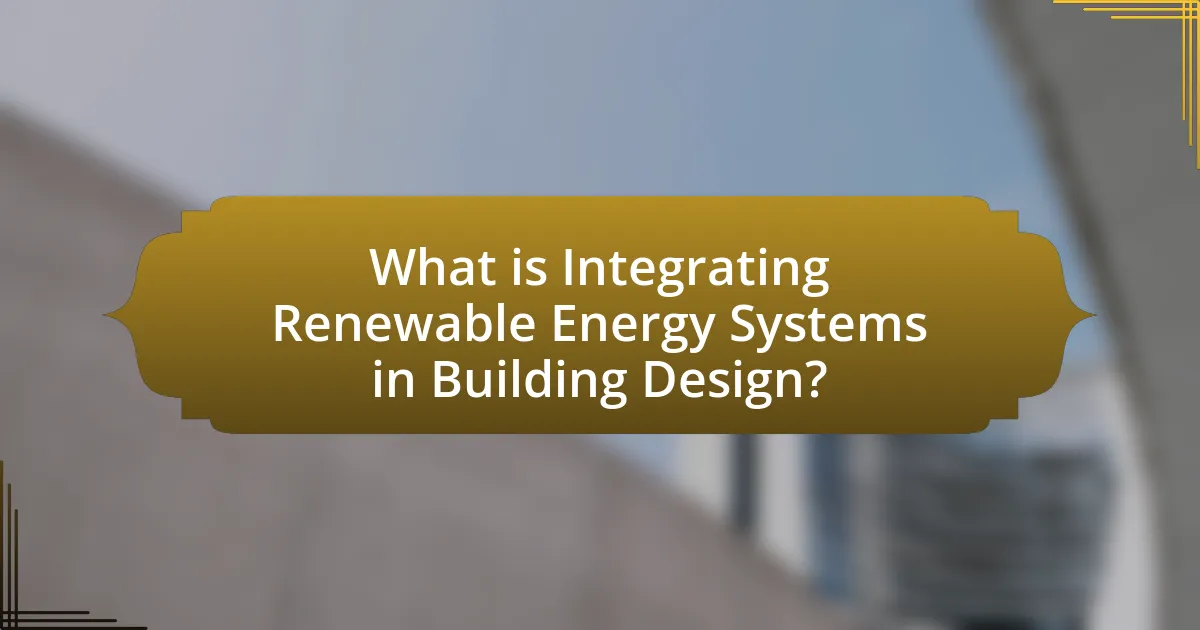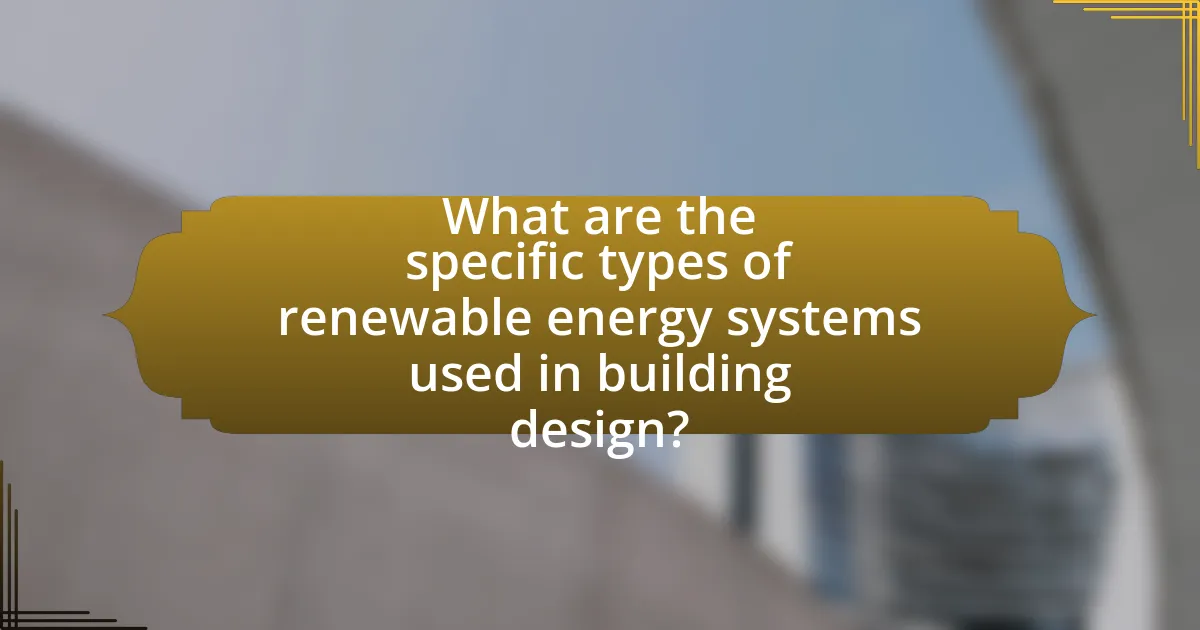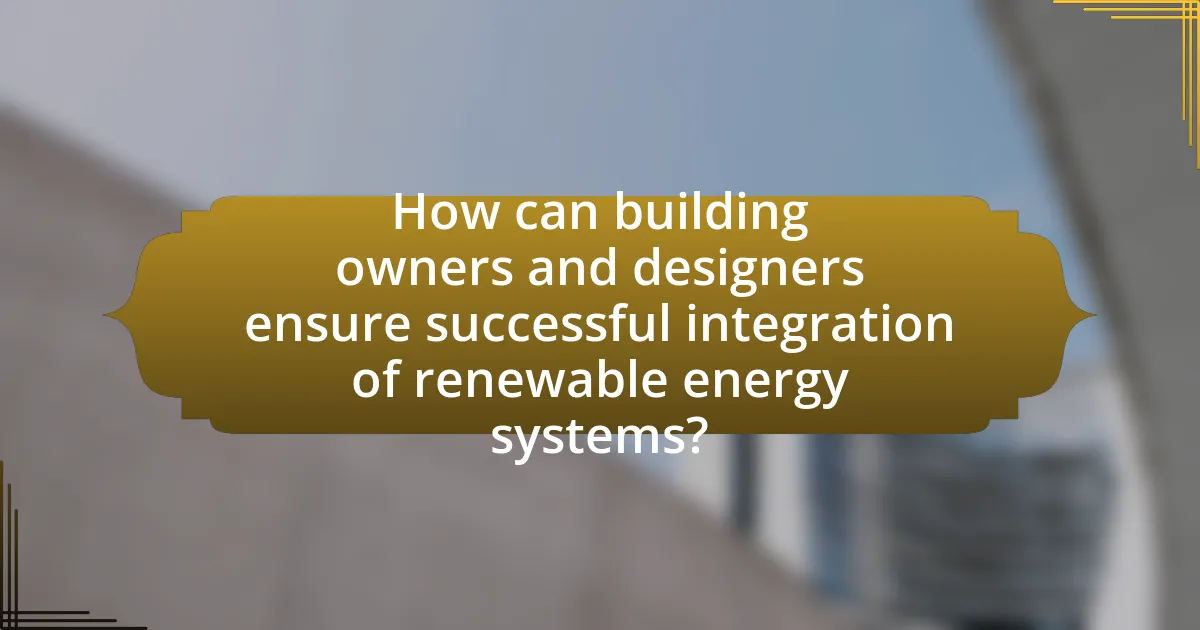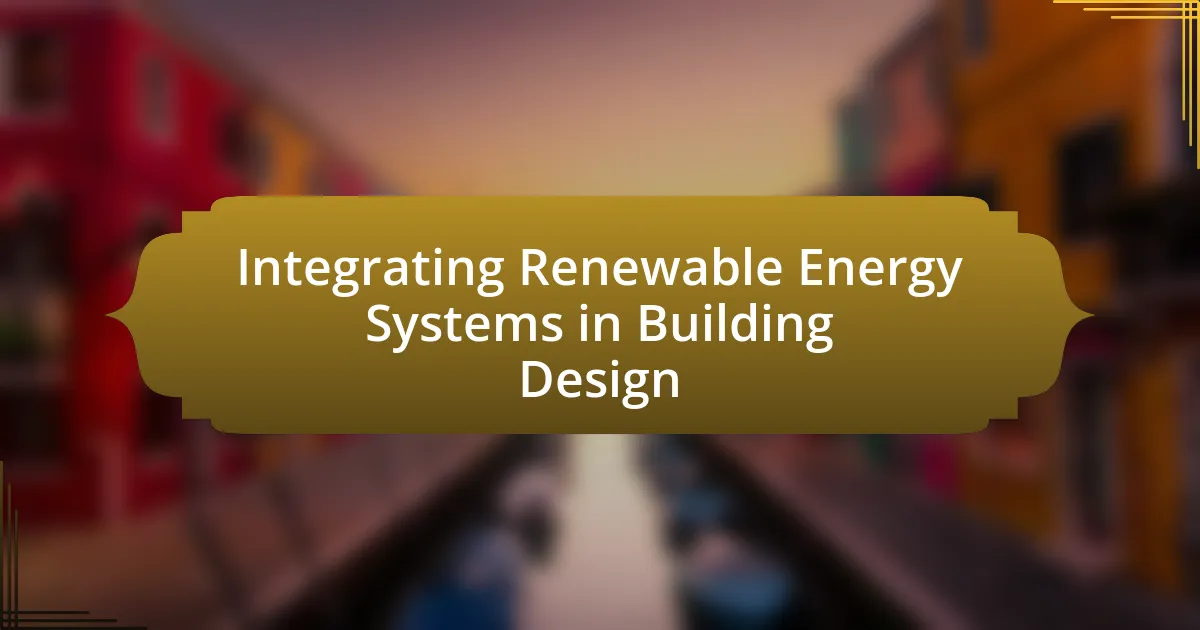Integrating renewable energy systems in building design involves the incorporation of sustainable technologies such as solar panels, wind turbines, and geothermal systems into the construction process. This approach enhances energy efficiency, reduces carbon emissions, and promotes the use of clean energy sources, with buildings accounting for approximately 40% of total energy consumption in the United States. The article explores the various types of renewable energy systems, their impact on energy efficiency, the environmental benefits, and the challenges faced during integration. It also discusses best practices for successful implementation, including site assessments, system sizing, and compliance with regulations, while highlighting the financial implications and long-term benefits for building occupants.

What is Integrating Renewable Energy Systems in Building Design?
Integrating renewable energy systems in building design refers to the incorporation of sustainable energy technologies, such as solar panels, wind turbines, and geothermal systems, into the architectural and engineering processes of constructing buildings. This approach aims to enhance energy efficiency, reduce carbon emissions, and promote the use of clean energy sources. For instance, buildings designed with integrated solar photovoltaic systems can generate their own electricity, significantly lowering reliance on fossil fuels. According to the U.S. Department of Energy, buildings account for approximately 40% of total energy consumption in the United States, highlighting the importance of integrating renewable energy systems to achieve sustainability goals.
How do renewable energy systems contribute to building design?
Renewable energy systems significantly enhance building design by improving energy efficiency and sustainability. These systems, such as solar panels, wind turbines, and geothermal heating, allow buildings to generate their own energy, reducing reliance on fossil fuels. For instance, buildings equipped with solar photovoltaic systems can produce up to 100% of their energy needs, leading to lower operational costs and a reduced carbon footprint. Additionally, integrating these systems into the architectural design can optimize natural light and ventilation, further enhancing energy performance. Studies show that buildings designed with renewable energy systems can achieve energy savings of 30% to 50% compared to traditional designs, demonstrating their critical role in modern architecture.
What types of renewable energy systems are commonly integrated into buildings?
Commonly integrated renewable energy systems in buildings include solar photovoltaic (PV) systems, solar thermal systems, wind turbines, geothermal heating and cooling systems, and biomass heating systems. Solar photovoltaic systems convert sunlight into electricity, making them a popular choice for reducing energy costs and carbon footprints. Solar thermal systems utilize sunlight to heat water for domestic use or space heating. Wind turbines can generate electricity on-site, particularly in areas with sufficient wind resources. Geothermal systems leverage the earth’s stable temperature for efficient heating and cooling, while biomass heating systems use organic materials for energy, providing a sustainable alternative to fossil fuels. These systems collectively contribute to energy efficiency and sustainability in building design.
How do these systems impact energy efficiency in buildings?
Renewable energy systems significantly enhance energy efficiency in buildings by reducing reliance on non-renewable energy sources and optimizing energy consumption. These systems, such as solar panels and wind turbines, generate clean energy on-site, which decreases the overall energy demand from the grid. For instance, buildings equipped with solar photovoltaic systems can produce up to 100% of their electricity needs, leading to substantial reductions in energy costs and greenhouse gas emissions. Additionally, integrating energy storage solutions allows buildings to utilize generated energy during peak demand times, further improving efficiency and reducing energy waste. Studies have shown that buildings utilizing renewable energy systems can achieve energy savings of 30% to 50% compared to traditional energy sources, validating their impact on energy efficiency.
Why is integrating renewable energy systems important in modern architecture?
Integrating renewable energy systems is important in modern architecture because it enhances energy efficiency and reduces environmental impact. By incorporating technologies such as solar panels, wind turbines, and geothermal systems, buildings can generate their own energy, leading to lower utility costs and decreased reliance on fossil fuels. According to the U.S. Department of Energy, buildings account for approximately 40% of total energy consumption in the United States, highlighting the significant potential for energy savings through renewable integration. Furthermore, the use of renewable energy systems contributes to sustainability goals, helping to mitigate climate change and promote a healthier environment.
What are the environmental benefits of using renewable energy in buildings?
Using renewable energy in buildings significantly reduces greenhouse gas emissions, which is crucial for combating climate change. By harnessing sources like solar, wind, and geothermal energy, buildings can operate with minimal reliance on fossil fuels, leading to a decrease in carbon dioxide emissions. For instance, the U.S. Department of Energy reports that buildings account for nearly 40% of total energy consumption and a substantial portion of greenhouse gas emissions. Transitioning to renewable energy can lower these emissions by up to 80% in some cases, contributing to improved air quality and reduced environmental degradation. Additionally, renewable energy systems often require less water than traditional energy sources, further conserving vital water resources and protecting aquatic ecosystems.
How does integrating these systems affect building regulations and standards?
Integrating renewable energy systems into building design significantly influences building regulations and standards by necessitating updates to compliance requirements. These updates often include new energy efficiency benchmarks, safety protocols, and sustainability criteria that align with the integration of technologies such as solar panels and energy storage systems. For instance, the International Energy Conservation Code (IECC) has evolved to incorporate provisions for renewable energy systems, mandating that buildings meet specific performance metrics related to energy generation and consumption. This integration not only promotes environmental sustainability but also drives innovation in building practices, ensuring that structures are designed to be more energy-efficient and resilient.
What challenges are faced when integrating renewable energy systems in building design?
Integrating renewable energy systems in building design faces several challenges, including high initial costs, regulatory hurdles, and technical limitations. High initial costs can deter investment, as renewable technologies often require significant upfront capital, despite long-term savings. Regulatory hurdles arise from complex building codes and zoning laws that may not accommodate innovative energy solutions. Technical limitations include the need for specialized knowledge and skills to design and implement these systems effectively, as well as potential issues with energy storage and grid integration. These challenges can hinder the widespread adoption of renewable energy in building projects.
What are the financial implications of integrating renewable energy systems?
Integrating renewable energy systems has significant financial implications, primarily involving initial capital investment, long-term savings, and potential revenue generation. The upfront costs for technologies such as solar panels or wind turbines can be substantial, often ranging from $15,000 to $30,000 for residential installations. However, these systems typically lead to reduced energy bills, with studies indicating savings of 50% or more on electricity costs over time. Additionally, renewable energy systems can increase property value; homes with solar installations have been shown to sell for approximately 4% more than comparable homes without them. Furthermore, government incentives, such as tax credits and rebates, can offset initial costs, making the financial transition more feasible. Overall, while the integration of renewable energy systems requires significant initial investment, the long-term financial benefits, including savings and increased property value, often outweigh these costs.
How can design professionals overcome technical challenges in integration?
Design professionals can overcome technical challenges in integration by employing a multidisciplinary approach that combines expertise from engineering, architecture, and environmental science. This collaboration enables the identification and resolution of potential conflicts early in the design process, ensuring that renewable energy systems are effectively integrated into building designs. For instance, utilizing Building Information Modeling (BIM) allows for precise visualization and simulation of energy systems, which can highlight integration issues before construction begins. Studies have shown that projects using BIM experience a 20% reduction in rework and a 15% increase in project efficiency, demonstrating the effectiveness of this approach in addressing technical challenges.
How can building designers effectively integrate renewable energy systems?
Building designers can effectively integrate renewable energy systems by conducting a comprehensive site analysis to assess solar, wind, and geothermal potential, which informs the selection of appropriate technologies. For instance, utilizing solar panels on rooftops can harness sunlight, while wind turbines can be strategically placed in areas with consistent wind patterns. Research indicates that buildings designed with integrated renewable energy systems can reduce energy costs by up to 50% and lower carbon emissions significantly, supporting sustainability goals. Furthermore, incorporating energy storage solutions, such as batteries, allows for the efficient use of generated energy, ensuring reliability and resilience in energy supply.
What design strategies enhance the effectiveness of renewable energy systems?
Design strategies that enhance the effectiveness of renewable energy systems include optimizing system orientation, utilizing energy-efficient materials, and implementing smart grid technologies. Optimizing system orientation, such as positioning solar panels at the optimal angle, can increase energy capture by up to 30%, as demonstrated in various studies. Utilizing energy-efficient materials in building design reduces overall energy demand, allowing renewable systems to meet a larger portion of the energy needs. Additionally, integrating smart grid technologies facilitates real-time energy management, improving the efficiency of energy distribution and consumption. These strategies collectively contribute to maximizing the performance and sustainability of renewable energy systems in building design.
How can collaboration with engineers improve integration outcomes?
Collaboration with engineers can significantly improve integration outcomes by ensuring that renewable energy systems are designed and implemented effectively within building projects. Engineers bring technical expertise that allows for the optimization of system performance, addressing potential challenges early in the design phase. For instance, a study by the National Renewable Energy Laboratory found that projects involving interdisciplinary collaboration, including engineers, resulted in a 20% increase in energy efficiency compared to those with limited collaboration. This demonstrates that effective teamwork leads to better planning, reduced costs, and enhanced functionality of renewable energy systems in building design.

What are the specific types of renewable energy systems used in building design?
The specific types of renewable energy systems used in building design include solar photovoltaic systems, solar thermal systems, wind energy systems, geothermal heating and cooling systems, and biomass energy systems. Solar photovoltaic systems convert sunlight directly into electricity, while solar thermal systems capture solar energy for heating water or spaces. Wind energy systems harness wind power to generate electricity, and geothermal systems utilize the earth’s stable temperatures for heating and cooling. Biomass energy systems convert organic materials into usable energy. These systems contribute to energy efficiency and sustainability in building design, aligning with global efforts to reduce carbon emissions and reliance on fossil fuels.
What is solar energy and how is it utilized in buildings?
Solar energy is the energy harnessed from sunlight, primarily through photovoltaic cells or solar thermal systems. In buildings, solar energy is utilized for electricity generation, heating water, and providing space heating, thereby reducing reliance on fossil fuels and lowering energy costs. For instance, photovoltaic panels installed on rooftops convert sunlight directly into electricity, which can power appliances and lighting. Additionally, solar thermal systems can capture heat from the sun to warm water for domestic use, contributing to energy efficiency. According to the U.S. Department of Energy, buildings equipped with solar energy systems can significantly decrease their carbon footprint and energy expenses, making solar energy a vital component in sustainable building design.
What are the different types of solar panels available for building integration?
The different types of solar panels available for building integration include monocrystalline, polycrystalline, and thin-film solar panels. Monocrystalline panels are made from a single crystal structure, offering high efficiency and space-saving benefits, typically achieving efficiencies of 15-22%. Polycrystalline panels consist of multiple crystal structures, providing a more cost-effective solution with efficiencies ranging from 13-16%. Thin-film solar panels are lightweight and flexible, suitable for unconventional surfaces, but generally have lower efficiencies of 10-12%. These variations allow for tailored integration into building designs based on aesthetic, efficiency, and space considerations.
How does solar energy impact building energy consumption?
Solar energy significantly reduces building energy consumption by providing a renewable source of electricity that can offset reliance on conventional energy sources. Buildings equipped with solar panels can generate their own electricity, leading to lower utility bills and decreased demand for grid power. According to the U.S. Department of Energy, solar energy can reduce energy costs by 50% or more in some cases, depending on the size of the installation and local energy prices. Additionally, integrating solar energy systems into building design enhances energy efficiency, as buildings can be optimized for solar orientation and shading, further minimizing energy consumption.
How is wind energy harnessed in building design?
Wind energy is harnessed in building design primarily through the integration of wind turbines and aerodynamic architectural features. Buildings can incorporate vertical or horizontal axis wind turbines on rooftops or within their structures to capture wind energy, converting it into electricity. Additionally, the design can include features such as wind scoops or strategically placed openings that enhance natural ventilation and airflow, optimizing energy efficiency. According to the U.S. Department of Energy, buildings designed with wind energy systems can significantly reduce reliance on non-renewable energy sources, contributing to sustainability goals.
What are the considerations for installing wind turbines on buildings?
Considerations for installing wind turbines on buildings include structural integrity, local zoning regulations, wind resource assessment, and potential noise impacts. Structural integrity is crucial as buildings must support the weight and dynamic loads of the turbine; for instance, a study by the National Renewable Energy Laboratory indicates that buildings may require reinforcement to accommodate these systems. Local zoning regulations often dictate where turbines can be installed, including height restrictions and setback requirements, which vary by municipality. Wind resource assessment is essential to ensure that the building site receives adequate wind speeds for effective energy generation; the American Wind Energy Association recommends a minimum average wind speed of 4.5 m/s for small turbines. Lastly, potential noise impacts from turbine operation must be considered, as some models can produce sound levels that may affect nearby occupants, with studies showing that noise levels can reach up to 50 dB at a distance of 30 meters.
How does wind energy contribute to overall energy efficiency?
Wind energy significantly enhances overall energy efficiency by converting kinetic energy from wind into electrical power without depleting resources. This renewable energy source reduces reliance on fossil fuels, which are less efficient and contribute to greenhouse gas emissions. According to the U.S. Department of Energy, wind energy has the potential to provide up to 20% of the nation’s electricity by 2030, demonstrating its capacity to meet energy demands sustainably. Additionally, wind turbines operate at a capacity factor of around 35-45%, meaning they can generate electricity consistently, thus optimizing energy use in buildings when integrated into design. This integration not only lowers operational costs but also minimizes energy waste, contributing to a more efficient energy system overall.
What role does geothermal energy play in building design?
Geothermal energy plays a crucial role in building design by providing a sustainable and efficient heating and cooling solution. This renewable energy source utilizes the stable temperatures found underground to regulate indoor climates, significantly reducing reliance on fossil fuels. According to the U.S. Department of Energy, geothermal heat pumps can reduce energy consumption for heating by 30% to 60% compared to conventional systems. Additionally, integrating geothermal systems into building design can lead to lower operational costs and a reduced carbon footprint, aligning with modern sustainability goals in architecture.
How can geothermal systems be integrated into new and existing buildings?
Geothermal systems can be integrated into new and existing buildings by utilizing ground-source heat pumps, which transfer heat to and from the ground for heating and cooling purposes. In new buildings, geothermal systems can be designed into the initial construction, allowing for the installation of vertical or horizontal ground loops that maximize energy efficiency. For existing buildings, retrofitting can involve drilling boreholes for vertical systems or installing horizontal loops in available land, enabling the building to harness geothermal energy without extensive structural changes. According to the U.S. Department of Energy, geothermal heat pumps can reduce energy costs by 30-60%, demonstrating their effectiveness in energy efficiency and sustainability.
What are the long-term benefits of geothermal energy for building occupants?
The long-term benefits of geothermal energy for building occupants include significant reductions in energy costs, enhanced indoor comfort, and improved environmental sustainability. Geothermal systems utilize the stable temperature of the earth to provide heating and cooling, leading to energy savings of 30% to 60% compared to conventional systems. This efficiency translates to lower utility bills for occupants over time. Additionally, geothermal energy systems contribute to a consistent indoor climate, minimizing temperature fluctuations and enhancing comfort levels. Furthermore, by reducing reliance on fossil fuels, geothermal energy systems lower greenhouse gas emissions, promoting a healthier environment for occupants and the community.

How can building owners and designers ensure successful integration of renewable energy systems?
Building owners and designers can ensure successful integration of renewable energy systems by conducting thorough site assessments and feasibility studies to evaluate the potential for solar, wind, or geothermal energy. These assessments help identify optimal locations for renewable installations, considering factors such as sunlight exposure, wind patterns, and ground conditions.
Additionally, incorporating renewable energy systems during the early design phase allows for better integration with the building’s architecture and systems, which can enhance energy efficiency and reduce costs. For instance, aligning solar panels with roof angles can maximize energy capture.
Furthermore, adhering to local regulations and standards, such as the International Energy Conservation Code, ensures compliance and can facilitate smoother project approvals. Engaging with experienced professionals in renewable energy design and installation can also provide valuable insights and technical expertise, leading to more effective system integration.
Research indicates that buildings designed with integrated renewable energy systems can achieve energy savings of up to 50%, demonstrating the effectiveness of these strategies in real-world applications.
What best practices should be followed for integrating renewable energy systems?
Best practices for integrating renewable energy systems include conducting a comprehensive energy audit, selecting appropriate technologies, and ensuring system compatibility with existing infrastructure. A thorough energy audit identifies energy consumption patterns and potential savings, which informs the selection of suitable renewable technologies such as solar panels or wind turbines. Additionally, ensuring compatibility with existing systems, such as HVAC and electrical grids, maximizes efficiency and performance. According to the U.S. Department of Energy, integrating renewable energy can reduce energy costs by up to 50% when properly implemented, demonstrating the effectiveness of these best practices.
How can ongoing maintenance and monitoring improve system performance?
Ongoing maintenance and monitoring significantly enhance system performance by ensuring optimal operation and early detection of issues. Regular maintenance activities, such as cleaning solar panels and inspecting wind turbines, can increase energy efficiency by up to 20%, as reported by the National Renewable Energy Laboratory. Monitoring systems provide real-time data, allowing for immediate adjustments and reducing downtime, which can lead to performance improvements of 15% or more in renewable energy systems. This proactive approach not only maximizes energy output but also extends the lifespan of the equipment, ultimately leading to better overall system performance.
What resources are available for building professionals to stay updated on renewable energy technologies?
Building professionals can utilize various resources to stay updated on renewable energy technologies, including industry publications, online courses, webinars, and professional organizations. Industry publications such as the Journal of Renewable and Sustainable Energy provide peer-reviewed research and case studies, while platforms like Coursera and edX offer online courses on renewable energy topics. Webinars hosted by organizations like the American Solar Energy Society present current trends and innovations. Additionally, professional organizations such as the International Renewable Energy Agency (IRENA) and the U.S. Green Building Council (USGBC) provide valuable resources, networking opportunities, and access to the latest research and guidelines in renewable energy integration within building design.
What common mistakes should be avoided when integrating renewable energy systems?
Common mistakes to avoid when integrating renewable energy systems include inadequate site assessment, poor system sizing, neglecting energy efficiency measures, and failing to consider local regulations. Inadequate site assessment can lead to misplacement of solar panels or wind turbines, resulting in reduced energy generation. Poor system sizing, whether oversized or undersized, can lead to inefficiencies and increased costs. Neglecting energy efficiency measures before installation can diminish the overall effectiveness of renewable systems, as energy savings from efficiency can complement renewable generation. Lastly, failing to consider local regulations can result in legal issues or project delays, as compliance with zoning laws and building codes is essential for successful integration.
How can improper sizing of systems lead to inefficiencies?
Improper sizing of systems can lead to inefficiencies by causing mismatches between energy supply and demand. When systems, such as solar panels or HVAC units, are not sized correctly, they may operate below optimal capacity or cycle on and off excessively, leading to increased energy consumption and wear. For example, an oversized HVAC system can cool a space too quickly, resulting in frequent cycling that wastes energy and reduces comfort. Studies indicate that properly sized systems can improve energy efficiency by up to 30%, demonstrating the significant impact of correct sizing on operational performance.
What are the risks of neglecting local regulations and incentives?
Neglecting local regulations and incentives poses significant risks, including legal penalties, financial losses, and project delays. Non-compliance with regulations can lead to fines or legal action from local authorities, which can escalate costs and jeopardize project viability. Additionally, overlooking available incentives, such as tax credits or grants, can result in missed financial opportunities that could enhance project affordability and sustainability. For instance, the U.S. Department of Energy reports that adherence to local building codes can improve energy efficiency by up to 30%, highlighting the importance of integrating regulations into project planning.
What practical tips can enhance the integration of renewable energy systems in building design?
To enhance the integration of renewable energy systems in building design, architects and engineers should prioritize site orientation and energy efficiency. Proper site orientation maximizes solar exposure, allowing for optimal solar panel placement, which can increase energy generation by up to 30% according to the National Renewable Energy Laboratory. Additionally, incorporating energy-efficient materials and designs, such as high-performance insulation and energy-efficient windows, reduces overall energy demand, making renewable systems more effective. Implementing smart building technologies can further optimize energy use by adjusting consumption based on real-time data, thereby improving the overall performance of renewable energy systems.

Leave a Reply